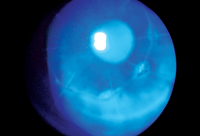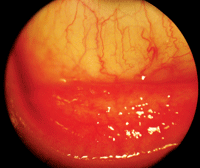 Optometrists primarily use topical non-steroidal anti-inflammatory drugs (NSAIDs) during postoperative care, such as after cataract surgery, corneal refractive procedures or even retinal injections. Not only do NSAIDs greatly help in the management of pain, but also these agents can reduce the severity of inflammation and swelling.1,2
Optometrists primarily use topical non-steroidal anti-inflammatory drugs (NSAIDs) during postoperative care, such as after cataract surgery, corneal refractive procedures or even retinal injections. Not only do NSAIDs greatly help in the management of pain, but also these agents can reduce the severity of inflammation and swelling.1,2
Such key attributes may also play a fundamental role in primary eye care applications.
Mechanism of Action
NSAIDs typically demonstrate rapid and prolonged pain control for the cornea, and the analgesic effects can last as long as 24 hours.3 NSAIDs often provide more effective relief from corneal pain than topical corticosteroids.4
This could be because of their targeted approach at mitigating prostaglandin production via the cyclo-oxygenase pathway, as opposed to the steroid mechanism of inhibiting the entire arachidonic acid pathway.5 While steroids tend to provide effective pain management when acting on inflammation-based tissue swelling, NSAIDs provide markedly better pain control when significant inflammation is not present.
Topical NSAIDs also have the added benefit of acting as a temporary anesthetic on all types of corneal sensory fibers––including mechanical, chemical and thermal receptors––before their analgesic properties are maximally achieved.6 This immediate loss of sensation contributes significantly to pain control. Unlike the analgesic effects, the anesthetic effect from NSAIDs is both short-lived and mild, and does not require the same amount of caution that would be necessary when using clinical anesthetics (such as tetracaine). The immediate relief that patients experience from topical NSAID use is key to increasing compliance when treating corneal inflammatory conditions and ocular trauma.
Pain Management

This patient, who underwent radial keratotomy,
presented with a failed lasso suture and reported
debilitating photophobia and dry eye. He exhibited
no benefit from topical steroid dosing, but
experienced complete symptom resolution
following one day of topical NSAID use.
Photo: Derek Cunningham, O.D.
One obvious example in which patients experience extreme pain and often require topical NSAIDs is in the event of a corneal abrasion. In fact, research has shown that topical NSAID dosing in conjunction with a bandage contact lens is a more effective treatment strategy than the use of either therapeutic approach alone.7
In addition to corneal abrasions, topical NSAIDs are useful in the management of pingueculitis, inflamed pterygium and scleritis.8,9 Further, these agents have been shown to enhance the comfort of bandage contact lenses in the management of persistent corneal epithelial defects.10 Other clinical applications for topical NSAIDs include the treatment of filamentary keratitis as well as pain management following PRK and various cases of blunt ocular trauma.11,12
In our offices, we have also had success in treating pain secondary to photokeratitis using NSAID eye drops. Adhering to the FDA-approved surgical dosing, we have had patients experience day-long pain control with as little as one drop of Bromday (bromfenac, Ista Pharmaceuticals). Typically, corneal healing is relatively fast, and pain control medication is required for just a few days.
Topical NSAIDs for CME
Topical NSAIDs have been shown to prevent retinal thickening after cataract surgery.13 So, you may wish to prescribe both oral and topical NSAIDs to patients with cystoid macular edema (CME) or even diabetic macular edema.
Today, many patients receive anti-VEGF therapy for CME. However, when this treatment option isn’t available or patients cannot see a retinal specialist in a timely manner, topical steroid dosing and topical/oral NSAID use may be warranted. In fact, many retinal specialists include topical NSAIDs before anti-VEGF injection to prepare the eye against pain and help reduce edema.
In addition to retinal surgery, topical NSAIDs may even increase the efficacy of several glaucoma surgeries, including implantation of the Ahmed Glaucoma Valve.14 Also, topical NSAIDs have been found to decrease postoperative pain associated with pan-retinal photocoagulation.15
Care With Topical NSAID Use

This patient experienced persistent ocular burning during allergy season, despite the use of antihistamine eye drops. But, temporary use of a topical NSAID q.d., in addition to antihistamine drops, completely relieved her burning symptoms during the peak of Mountain Cedar season.
Photo: Derek Cunningham, O.D.
Clinicians must be aware of potential complications associated with topical NSAID use. Corneal melts have been reported in patients with severe ocular surface diseases, such as Stevens Johnson syndrome.16
Although newer topical nsaids may cause corneal complications, the majority of problems have been associated with generic nsaid use.17 For example, generic diclofenac was implicated for numerous cases of corneal melts and toxicity in the late 1990s.18-20 One treatment center reported 18 complications, including keratitis, ulcerations and perforations (11 cases occurred following cataract surgery; one case was reported in a patient with sarcoid uveitis; and the remaining cases included patients with systemic diseases, such as rheumatoid arthritis, Sjögrens syndrome and rosacea).21
Also, optometrists must be adequately educated about the proper selection and application of topical NSAIDs to maximize therapeutic benefit and minimize adverse events. When making a selection, keep in mind that generic medications are not required to demonstrate safety, efficacy, absorption or tolerability (which are all affected by the inclusion of different preservatives, buffers, fillers, pH enhancers and manufacturing processes).
The Future
While further study is required, one emerging area of interesting research is the use of topical NSAIDs for the long-term management of chronic dry eye. Current studies are evaluating the therapeutic benefits of low-dose applications in the general dry eye population.22 Until that research is published, however, clinicians should use caution with liberal NSAID use in patients with advanced ocular surface disease.
And most recently, several research groups have examined the anti-inflammatory impact of topical NSAIDs in patients with diabetic retinopathy and age-related macular degeneration.23-25
Thanks to Derek N. Cunningham, O.D., director of research and optometry at Dell Laser Consultants in Austin, Texas, for contributing to this article. He has received research support from Allergan, Alcon, Bausch + Lomb and Ista Pharmaceuticals. Dr. Karpecki is a paid consultant to Allergan, Alcon, Bausch + Lomb and Ista Pharmaceuticals. Drs. Karpecki, Shechtman and Cunningham have no direct financial interest in any of the products mentioned.
1. Weaver CS, Terrell KM. Evidence-based emergency medicine. Update: do ophthalmic nonsteroidal anti-inflammatory drugs reduce the pain associated with simple corneal abrasion without delaying healing? Ann Emerg Med. 2003 Jan;41(1):134-40.
2. Blaydes JE Jr, Kelley EP, Walt JG, et al. J Cataract Refract Surg. Flurbiprofen 0.03% for the control of inflammation following cataract extraction by phacoemulsification. 1993 Jul;19(4):481-7.
3. Brahma AK. Topical analgesia for superficial corneal injuries. J Accid Emerg Med. 1996 May;13(3):186-8.
4. Badala F, Fioretto M, Macri A. Effect of topical 0.1% indomethacin solution versus 0.1% fluorometholone acetate on ocular surface and pain control following laser subepithelial keratomileusis (LASEK). Cornea. 2004 Aug;23(6):550-3.
5. Phillips AF, Szerenzi K, Campos M, et al. Arachidonic acid metabolites after excimer laser corneal surgery. Arch Ophthalmol. 1993 Sep;111(9):1273-8.
6. Acosta MC, Berenguer-Ruiz L, Garcia-Galvez A, et al. Changes in mechanical, chemical, and thermal sensitivity of the cornea after topical application of nonsteroidal anti-inflammatory drugs. Invest Ophthalmol Vis Sci. 2005 Jan;46(1):282-6.
7. Donnenfeld ED, Selkin BA, Perry HD. Controlled evaluation of a bandage contact lens and a topical nonsteroidal anti-inflammatory drug in treating traumatic corneal abrasions. Ophthalmology. 1995 Jun;102(6):979-84.
8. Frucht-Pery J, Solomon A, Siganos CS. Treatment of inflamed pterygium and pinguecula with topical indomethacin 0.1% solution. Cornea. 1997 Jan;16(1):42-7.
9. Ramirez-Ortiz MA, Vasquez-Resendis A. Isolated bilateral posterior scleritis after eye trauma. J AAPOS. 2007 Jun;11(3):284-5.
10. Oskouee SJ. Bandage contact lens and topical indomethacin for treating persistent corneal epithelial defects after vitreoretinal surgery. Cornea. 2007 Dec;26(10):1178-81.
11. Avisar R, Robinson A, Appel I, et al. Diclofenac sodium, 0.1% (Voltaren Ophtha), versus sodium chloride, 5%, in the treatment of filamentary keratitis. Cornea. 2000 Mar;19(2):145-7.
12. Grinbaum A, Yassur I, Avni I. The beneficial effect of diclofenac sodium in the treatment of filamentary keratitis. Arch Ophthalmol. 2001 Jun;119(6):926-7.
13. Endo N, Kato S, Haruyama K, et al. Efficacy of bromfenac sodium ophthalmic solution in preventing cystoid macular oedema after cataract surgery in patients with diabetes. Acta Ophthalmol. 2010 Dec;88(8):896-900.
14. OScott GR, Weizer JS, Moroi SE, et al. Can topical ketorolac 0.5% improve the function of Ahmed glaucoma drainage devices? Ophthalmic Surg Lasers Imaging. 2011 May-Jun;42(3):190-5.
15. Zakrzewski PA, O’Donnell HL, Lam WC. Oral versus topical diclofenac for pain prevention during panretinal photocoagulation. Ophthalmology. 2009 Jun;116(6):1168-74.
16. Isawi H, Dhaliwal DK. Corneal melting and perforation in Stevens Johnson syndrome following topical bromfenac use. J Cataract Refract Surg. 2007 Sep;33(9):1644-6.
17. Bekendam PD, Narvaez J, Agarwal M. Case of corneal melting associated with the use of topical nepafenac. Cornea. 2007 Sep;26(8):1002-3.
18. Flach A. Topically applied nonsteroidal anti-inflammatory drugs and corneal problems: an interim review and comment. Ophthalmology. 2000 Jul;107(7):1224-122.
19. Lin JC, Rapuano CJ, Laibson PR, et al. Corneal melting associated with use of topical nonsteroidal anti-inflammatory drugs after ocular surgery. Arch Ophthalmol. 2000 Aug;118(8):1129-32.
20. Gills JP. Voltaren associated with medication keratitis. J Cataract Refract Surg. 1994 Jan;20(1):110.
21. Guidera AC, Luchs JI, Udel IJ. Keratitis, ulceration, and perforation associated with topical nonsteroidal anti-inflammatory drugs. Ophthalmology. 2001 May;108(5):936-44.
22. Aragona P, Stilo A, Ferreri F, et al. Effects of the topical treatment with NSAIDs on corneal sensitivity and ocular surface of Sjögren’s syndrome patients. Eye (Lond). 2005 May;19(5):535-23. Gerhardinger C. The transforming growth factor-beta pathway is a common target of drugs that prevent experimental diabetic retinopathy. Diabetes. 2009 Jul;58(7):1659-67.
24. Wang Y, Wang VM, Chan CC. The role of anti-inflammatory agents in age-related macular degeneration (AMD) treatment. Eye (Lond). 2011 Feb;25(2):127-39.
25. Kim JS, Flach AJ, Jampol LM. Nonsteroidal anti-inflammatory drugs in ophthalmology. Surv Ophthalmol. 2010 Mar 4;55(2):108-33.

